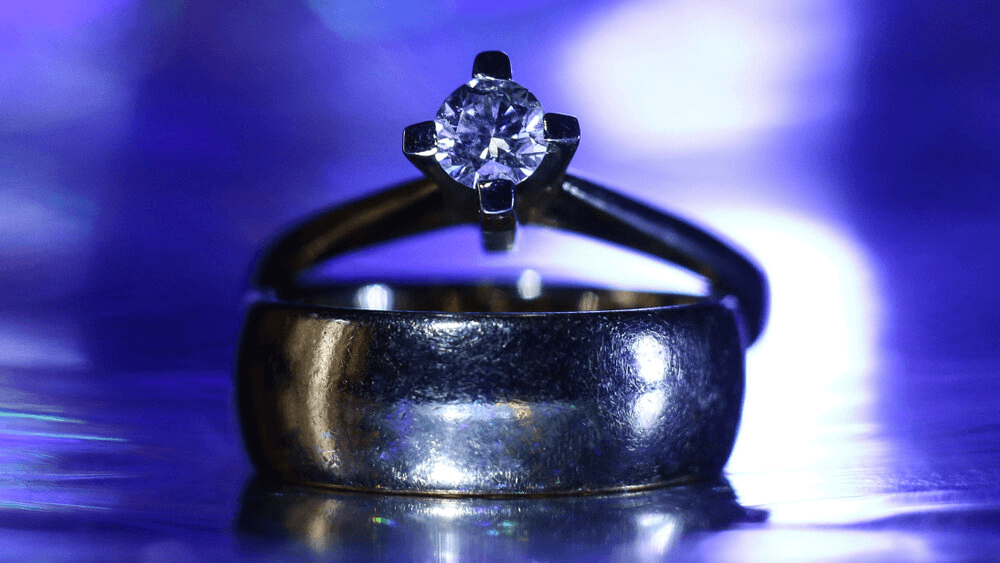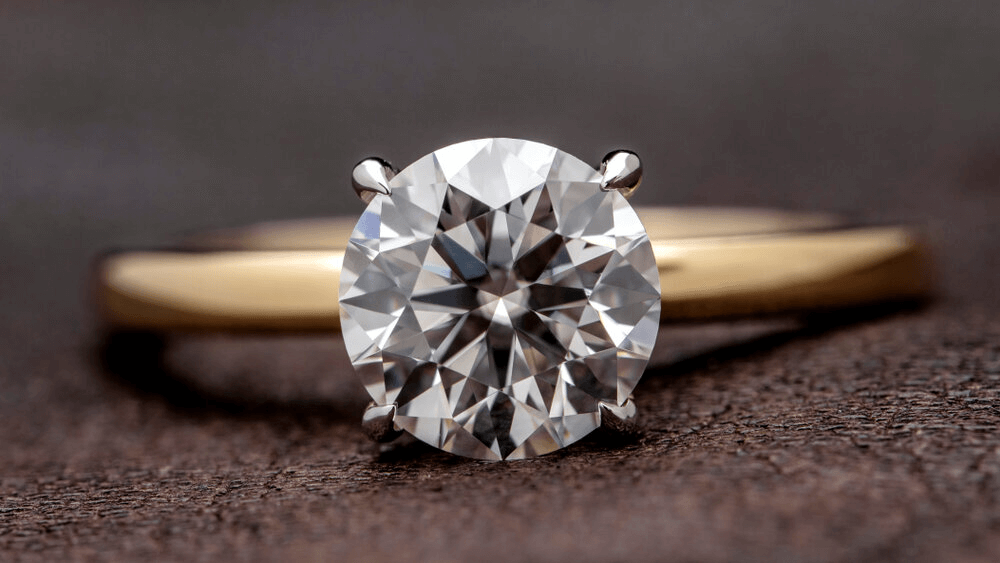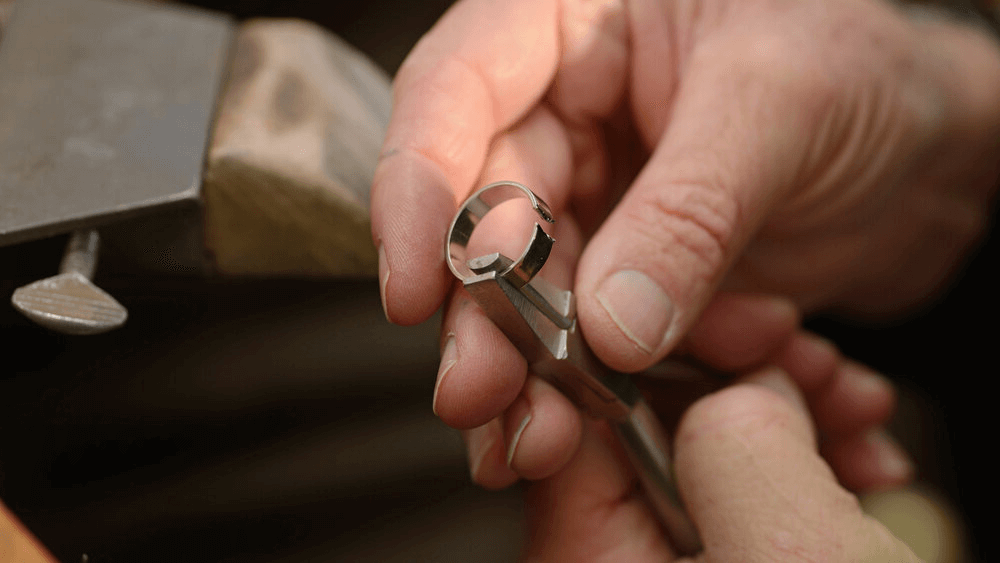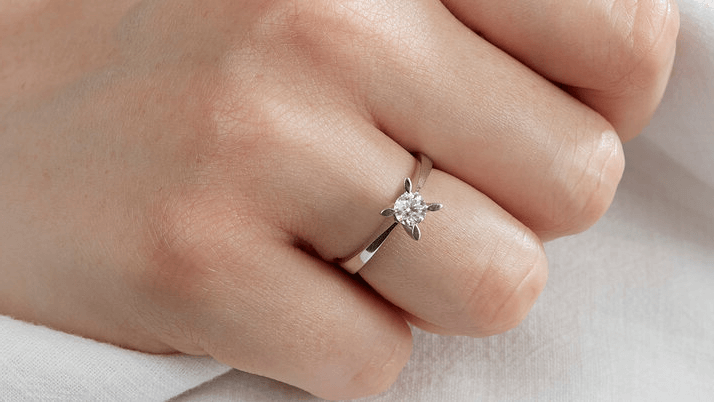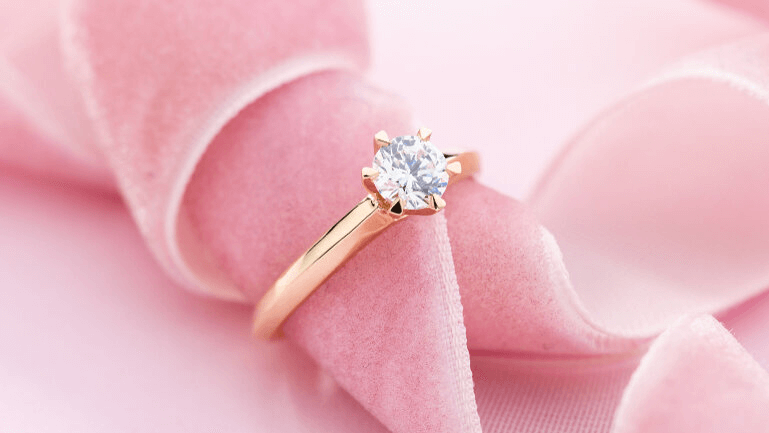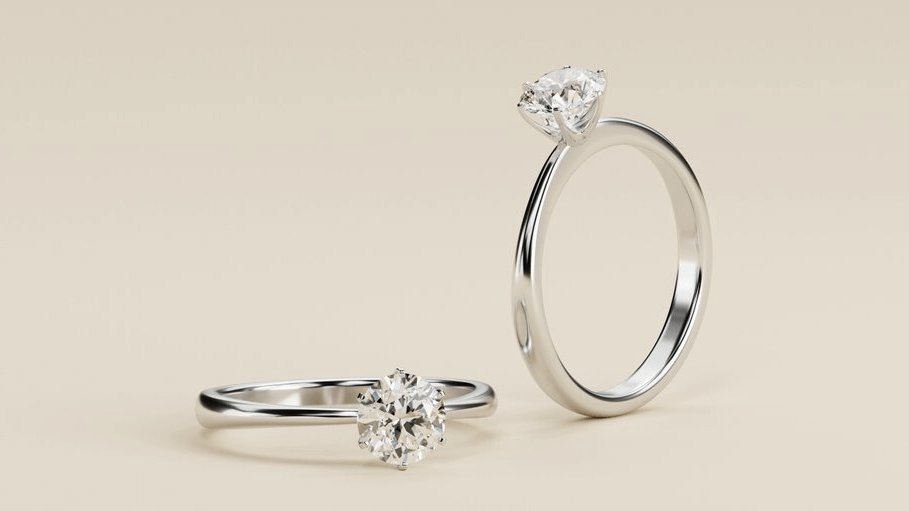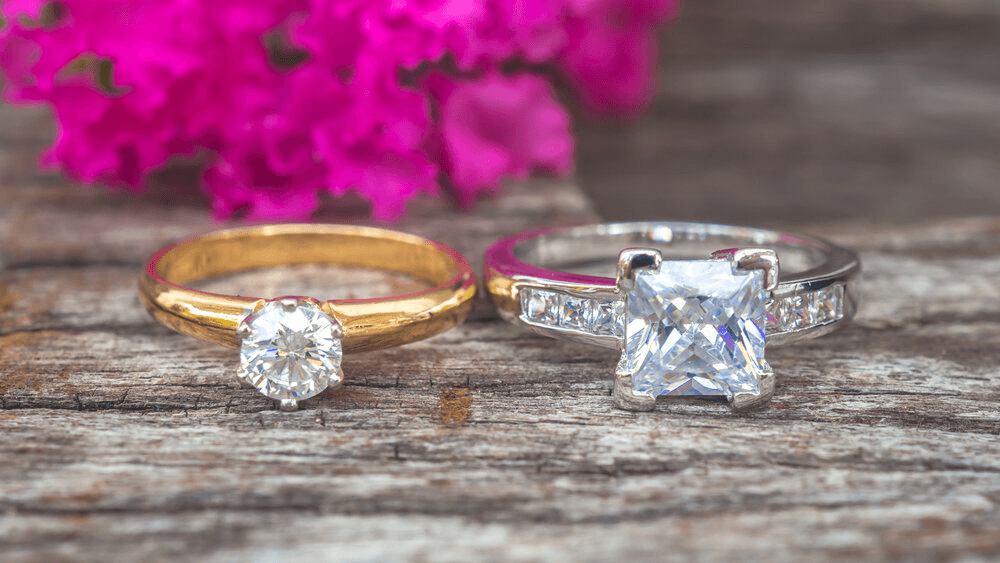Unlock the Magic of White Gold Dipping

By Gary A.

Edited by Olivia H.
Published Mar 26, 2022
Edited on Mar 31, 2025
To maintain the beautiful shine of your white gold jewelry, white gold ring dipping plays a key role in keeping your piece looking as bright and fresh as the day you bought it.

- 7 Quick Tips and Considerations When Buying a Diamond Engagement Ring and Examining White Gold Dipping
- Introduction
- Composition and Characteristics of White Gold
- The Basics of White Gold Ring Dipping
- Frequency of Redipping: When to Get White Gold Ring Redipped
- Cost Implications
- Our Expert Take
- 10 Frequently Asked Questions about White Gold Ring Dipping
Before we dive deeper into the specifics, here are some practical tips to help guide your decision-making process:
7 Quick Tips and Considerations When Buying a Diamond Engagement Ring and Examining White Gold Dipping
When purchasing a diamond engagement ring set in white gold, it’s crucial to understand the nuances of white gold dipping, a process that significantly impacts the appearance and maintenance of the ring.
- Tip 1: Check for Uniformity in Color and Shine
- Examine the ring closely to ensure the rhodium plating (white gold dipping) is evenly applied.
- Look for consistent brightness and color throughout the ring, especially in hard-to-reach areas.
- Tip 2: Inquire About the Thickness of the Plating
- The thickness of the rhodium layer can vary; thicker plating generally lasts longer.
- Ask the jeweler about the micron level of the plating to gauge its quality and durability.
- Tip 3: Understand Re-Dipping Frequency
- Be aware that white gold dipped rings require periodic re-dipping to maintain their appearance.
- Discuss with the jeweler the typical timeframe for re-dipping based on your lifestyle and ring’s design.
- Tip 4: Consider Long-Term Maintenance Costs
- Factor in the cost of future white gold dipping sessions when budgeting for your ring.
- Regular maintenance ensures the ring retains its luster and prevents premature wear.
- Tip 5: Evaluate the Ring’s Design and Structure
- Intricate designs might affect how the white gold dipping wears over time.
- Rings with more texture and crevices might show uneven wear and require more frequent maintenance.
- Tip 6: Assess the Metal’s Quality Beneath the Plating
- The quality of the white gold underneath the rhodium plating is just as important.
- Higher quality white gold alloys will have a better appearance and durability even as the plating wears off.
- Tip 7: Be Mindful of Skin Sensitivities
- Some people are sensitive to metals used in white gold alloys, such as nickel.
- Ensure that the rhodium plating is hypoallergenic to avoid allergic reactions.
Now that you’ve got these practical tips, use Jeweler AI below to find the perfect engagement ring that suits your style and budget:
Introduction
White gold is one of the most popular metal choices for bridal jewelry. While it captures the same stark, bright vibe of platinum, it’s also a lot cheaper, as well as being strong and durable. White diamonds look incredible against it, just as it contrasts beautifully with colored accent stones.
Nevertheless, one of the most commonly touted arguments against white gold, and in favor of platinum, is that it’s higher maintenance. White gold pieces need to be re-dipped every once in a while, in order for them to stay looking as bright and shining as platinum. This routine maintenance, often referred to as ring dipping or white gold ring coating, ensures your jewelry retains its high-quality finish.
Then again, all engagement rings need to be regularly checked by the jeweler who created them, so is taking the time to get your white gold re-dipped really a big deal? Here’s everything you’ll need to know.
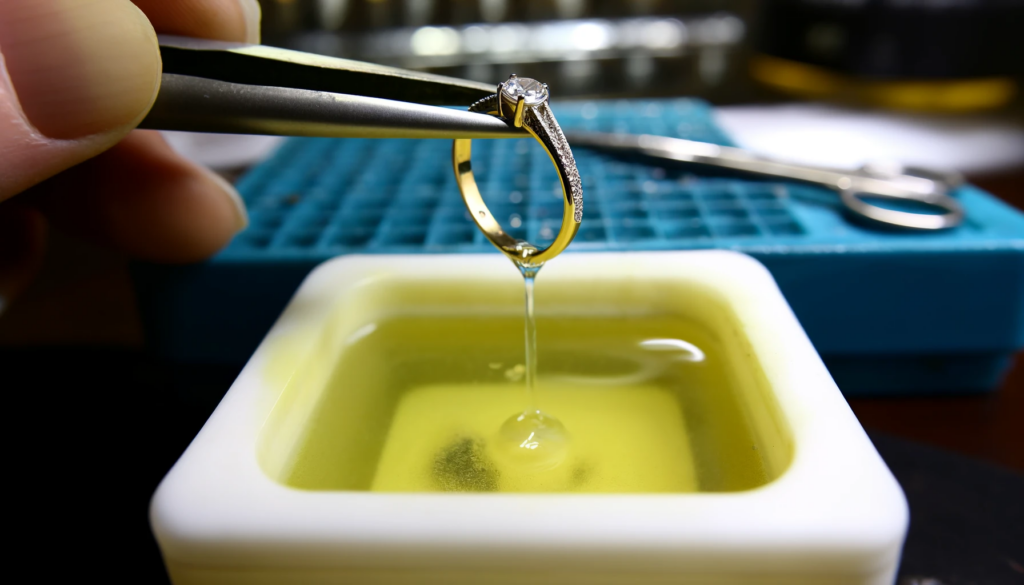
Composition and Characteristics of White Gold
White gold is made by combining pure gold with alloying metals chosen specifically for their bright white hues.
Most white gold is coated in a very thin layer of rhodium in order to achieve that bright, platinum-like color, but that original coating doesn’t last forever – particularly if you’re wearing the item regularly.
Yellow gold doesn’t need to be dipped, since it doesn’t have a coating to begin with. The same goes for rose gold – while the color has been changed, that pink hue is the result of a combination of gold with copper (and other alloys like silver). It is not achieved using a surface coating.

The Rhodium Advantage in Jewelry
If your white gold ring is plated, then it is inevitable that it will wear off and need replacing eventually. That doesn’t mean you can’t wear and enjoy it.
Some metals, like silver, just aren’t strong enough to be worn every day. Regular wear will cause them to get scratched, marked and bent out of shape and, eventually, look worse for the wear.
White gold is strong. It’s usually sold as 10K or 14K, which means it’s more than capable of withstanding life on your finger. There’s nothing wrong with wearing it every day – although you’ll want to avoid wearing it to swim, workout, sleep, or rock climb, but that’s the same for any precious metal, particularly when there are diamonds involved.
In other words, don’t get anxious about the plating wearing off. It’s going to wear off, and it’s easy enough to replace it.
The Basics of White Gold Engagement Ring Dipping
White gold doesn’t have to be plated in rhodium, but most people prefer it. It’s created using alloys like nickel and zinc and, before being dipped in rhodium, will appear a very, very pale yellow color. It’ll be close to the color you typically associate with white gold, but still feature a discernible hint of warmth.
This is the color you’ll start to see when the rhodium plate starts to wear off your ring – a very subtle hint of gold’s warm, yellow color. It won’t be obvious, and it’s not a big deal, and you’ll probably be the only person to notice it.
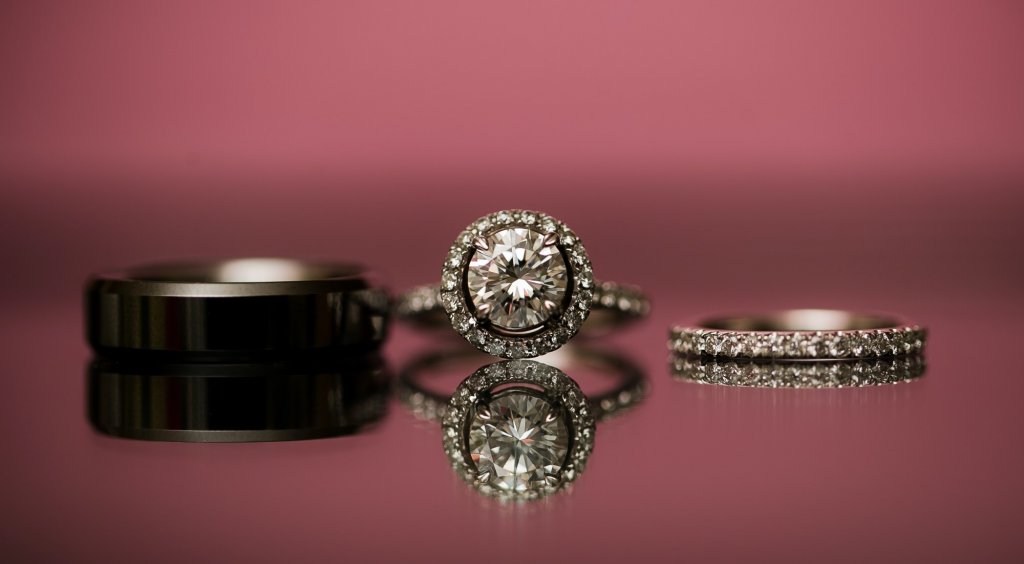
Frequency of Redipping: When to Get White Gold Ring Redipped
In general, rhodium plating lasts between 1 and 3 years.
As you can imagine, gold plating will last longer on some pieces of jewelry than it will on others. A pair of white gold earrings worn once in a blue moon will stay looking bright for a lot longer than a wedding band. Not only is a ring subjected to a lot more wear and tear, but a wedding band is worn day-in-day-out from the moment it is first purchased, and this will cause the plating to wear off much faster.
You don’t need to panic if your white gold plating starts to show signs of wearing off within the first 12 months of purchasing it. It’s simply a sign that the piece has been worn and enjoyed and that it’s ready for a routine tune-up. For those wondering how much ring dipping costs, it varies, but understanding these expenses is crucial for proper jewelry care.
On a ring, the first place you’re likely to notice the plating wearing off is the inside of the band. Since it’s constantly rubbing against your finger, it’s a lot quicker to wear away there than on the ring’s head, which tends to be left alone most of the time.
Since the less conspicuous parts of the ring will wear off first, you may not need to get it redipped the instant you start to see signs of wear and tear.
Maintenance and Care
Avoid anything that’s going to subject your ring to unnecessary abrasion – harsh scouring pads or scrubbing cloths can really wear down that plating fast, so consider taking your ring off before doing anything that may impact the finish.
Clean your ring with warm water and mild soap, and consider taking it to a local jeweler for a proper clean every few months.
Cost Implications
It totally depends on the jeweler and your state, but it generally costs between $50 and $150.
Re-dipping a white gold ring in rhodium is a relatively quick process, but it’s not a five-minute job. The jeweler will need to polish off what’s left of the previous plating, clean the ring, then dip it in the plating and leave it to dry before giving it a final check. This process, often termed redip ring or redip white gold ring, rejuvenates the appearance of your jewelry, making it look brand new.
For us, it’s more than worth the price. While working on the plating, the jeweler can take a look at your ring’s prongs, and any delicate features like a pavé setting on the shank, in order to make sure everything is safe and secure. We recommend you do this once or twice a year, to make sure everything’s as it should be.
Some people do like to invest in a temporary engagement ring for those times when the real ring is with the jeweler, but you won’t be parted from it for long.
Our Expert Take
White gold is a great choice for an engagement ring. It looks great, lasts for decades, and offers safe support for your diamond.
It’s true that it’s higher maintenance than platinum, but we’ve never considered this to be a particularly big deal. Getting a ring replated isn’t a major undertaking, and it gives you a chance to get the prongs checked too.
Whether it’s a wedding ring with dip or a simple engagement band, the ring dipping service can significantly extend the life and beauty of your ring.
10 Frequently Asked Questions about White Gold Ring Dipping
- Q1: What is white gold dipping?
- A1: White gold dipping, also known as rhodium plating, is a process where a thin layer of rhodium is applied to white gold jewelry to enhance its brightness and durability.
- Q2: How often does a white gold ring need to be re-dipped?
- A2: The frequency varies based on wear and care, but typically, a white gold ring needs re-dipping every 1-3 years.
- Q3: Can yellow gold be dipped to look like white gold?
- A3: Yes, yellow gold can be dipped in rhodium to give it a white gold appearance, but it’s a temporary solution and will eventually wear off.
- Q4: How much does it cost to have a ring dipped in white gold?
- A4: The cost varies, but generally, it ranges between $50 and $150, depending on the jeweler and the ring’s complexity.
- Q5: Will white gold dipping damage my ring?
- A5: No, when done professionally, white gold dipping enhances the ring’s appearance without damaging it.
- Q6: Can I dip my white gold ring at home?
- A6: It’s not recommended, as the process requires professional skills and equipment to ensure quality and safety.
- Q7: Does white gold dipping affect the ring’s value?
- A7: White gold dipping does not typically affect the intrinsic value of the ring but helps maintain its aesthetic appeal.
- Q8: How long does white gold dipping last?
- A8: On average, white gold dipping lasts 1-3 years, but this can vary based on the ring’s usage and exposure to elements.
- Q9: Is white gold dipping necessary for all white gold jewelry?
- A9: While not mandatory, it is commonly done to enhance the jewelry’s whiteness and luster.
- Q10: Can white gold dipping hide scratches or flaws in the metal?
- A10: Rhodium plating can minimize the appearance of minor scratches but won’t completely hide significant flaws.
Enhance your jewelry’s elegance with Jeweler AI’s white gold dipping. Experience precision, quality, and beauty in every detail.
FOLLOW-UP GUIDE SERIES

